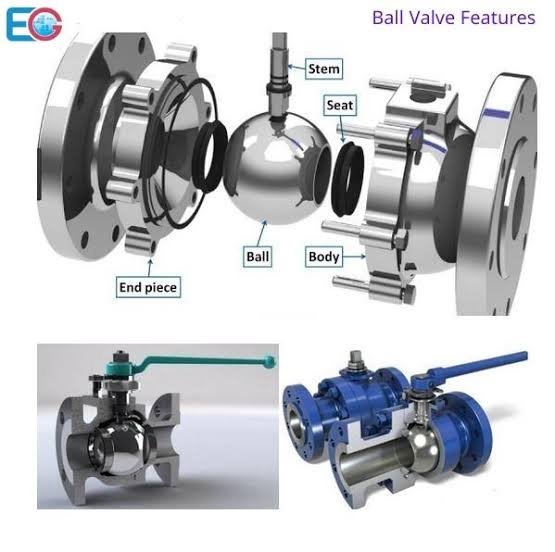The adaptability, corrosion resistance, and strength of stainless steel has changed industrial machinery. Among its many uses, stainless steel ball valves are particularly important parts of fluid control systems. Oil and gas, food processing, and other industries equally rely on these valves. This article examines the construction, benefits, and applications of stainless-steel ball valves, highlighting their excellence in challenging conditions.
What Are Stainless Steel Ball Valves?
The stainless-steel quarter turn ball valve utilizes a hollow sphere as a control feature which rotates around an axis to either allow liquid to pass freely or restrict the fluid’s flow. It is opened when the balls bore is parallel to the pipeline and stops the flow when rotated ninety degrees. Their valves trouble-free construction ensures steadfast sealing, reduced pressure drop, and fast operations.
Because of the stainless steel’s resistance to rust, high temperatures, and even chemical corrosion, these valves are suited for demanding applications. In less serious applications, 304 grade stainless steel is a cheap option, but 316 grade stainless steel is more commonly used in more severe applications due to its greater performance in corrosive environments.
Key Benefits
Durability and Longevity
The tolerance of stainless-steel ball valves for extreme high pressure (up to 3000 WOG) and exceptionally high temperatures (-40°F to 400°F) make them useful for chemical processing and pharmaceuticals. Their robust design minimizes wear even after prolonged and repeated use.
Corrosion Resistance
Unlike bronze or brass valves, they are bearable to corrosion and oxidation brought about by moisture, acids, and even chlorides. This oxidation resistance makes them suitable for food-grade systems where sanitary conditions are important, plumbing, and even marine applications.
Low Maintenance
Minimal upkeep is required due to PTFE sealing and blowout proof stem features. Simple cleaning and/or part replacement is made easier with three-piece designs which do not require complete valve removal from the pipeline.
Versatility
They are adaptable to various uses as they can be threaded, flanged, reduced-port, full-port or socket welded. For instance, valves with full port openings allow a maximum flow, while those with reduced opening ports save money and space.
Types of Stainless-Steel Ball Valves
Two-Piece Valves
The two-piece stainless steel ball valve is the most common design. Its strong body is divided into two parts. Such type of valve is widely used in HVAC systems and plumbing activities, and benefits from reasonable price in relation to the quality of service.
Three-Piece Valves
Three-piece valves, which allow for the central portion to be taken out while the rest of the pipeline remains connected, are ideal for moderate and high maintenance environments. Such design is prevalent in the pharmaceutical and brewing industry which is required to undergo frequent sterilization.
Flanged and Threaded Valves
Flanged stainless steel ball valves (like the 150 Class or 300 Class) are used in oil refineries and other high-pressure systems. In cramped spaces, installation is simpler with socket weld or NPT threaded variants.
Applications Across Industries
Food and Beverage
The stringent hygienic protocols in bottling plants, breweries, and dairy processing facilities are departed by stainless steel ball valves. Contamination is avoided due to their construction. PTFE materials guarantee compliance with FDA rulings and their surface is bacteria-free, preventing any chance of a possible outbreak.
Oil and Gas
Refinery or pipeline processes involving the flow of high-pressure steam and corrosive liquids is controlled by these valves. A good example would be the 316-grade stainless steel type which is oil pumping. It is considerably less corrosive in sulfur rich environments.
Pharmaceuticals
Maintaining pharmaceutical sterility is of utmost importance. The swing-out valve bodies and tri-clamp connections are easily cleanable for compliance with GMP standards.
Water Treatment
Stainless steel ball valves offer reliability for water distribution in desalination plants and municipal systems because they resist chlorine and other chemicals.
How to Choose the Right Valve
Carefully consider the characteristics of your system when selecting a valve. Take note of the most crucial components:
- Pressure Rating – Ensure that the valve will endure the working pressure of your system.
- Size and Flow Rate – Choose a valve that accommodates fluid flow at the specified rate.
- Material Grade – Grade 304 is more susceptible to corrosion when compared to grade 316.
- End Connection Type – Depending on the method of installation, threaded, flanged or welded connections may be appropriate.
- Sealing Mechanism – Guarantees smooth operation and no leakages that is dependable.
Installation and Maintenance Tips
- Appropriate Fitting: Make sure to follow guidance so that there is always a snug fit. It is best to ensure that a manufacturer’s installation is always correct.
- Display The Maintenance Results: Learn to understand the signs of probable components of a malfunction for a constantly expected failure prevention plan in place. Change proof principles need to be integrated.
- Periodic Oil Service: Regular oil service is recommended on certain valves for them to function appropriately.
- Valve Maintenance: Maintenance works like cleaning ought to be done to the structure to ensure the valve work more efficiently and last longer.
Conclusion
None can compare to the tenacious strength, corrosion resistance, and variation of the stainless-steel ball valves. Their notoriety is mostly common in sectors that need efficient flow control service. In water treatment facilities, chemical manufacturing, and food processing plants, these valves maintain maximum efficiency and safety. Low maintenance premium stainless steel ball valves guarantee flawless long-term performance.
Be mindful of the valve’s material grade, application, and its pressure rating. That guarantees optimal performance and lifetime of the valve. As a result, those searching for dependable, budget friendly stainless steel ball valves and fluid control systems need not look any further.

